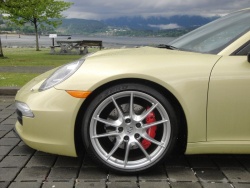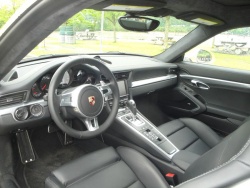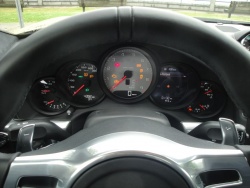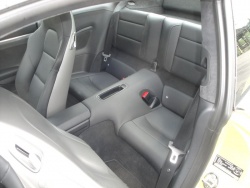2012 Porsche 911 Carrera S. Click image to enlarge |
|
First Drive: 2012 Porsche 911
Manufacturer’s web site |
Review and photos by Greg Wilson
Photo Gallery:
2012 Porsche 911
You’ll notice that this is the same 2012 Porsche 911 Carrera S reviewed by Peter Bleakney a couple of months ago. But hey, it’s always nice to get a second opinion about the same car — especially if it’s a different opinion…
As Peter points out, the all-new 911 “is a much easier car to live with on a day-to-day basis”, but personally, I wouldn’t recommend it. The main problem is the 911’s stiff ride. On smooth blacktop it’s okay, but given the state of our roads these days—potholes, broken pavement, construction everywhere—the 911 rides like an oxcart, even though it features shocks that automatically adapt to different road surfaces.
And while it handles with rock-solid stability and tenacious grip, if it’s raining, the 911 Carrera S’s extremely wide summer tires—my car had Pirelli P Zero P245/35ZR20-inch (front) and P295/30ZR20-inch (rear) performance tires—tend to hydroplane through standing water. And in the dry, these tires are quite noisy.
2012 Porsche 911 Carrera S. Click image to enlarge |
As well, the 911 is such a low car—even lower than the previous 911—that getting in and out can be a chore, especially for the older demographic that has the money to afford one of these cars. On the road, the 911 is so low that other drivers (mostly pickup drivers) can’t see you when changing lanes, making for some nerve-wracking brake-and-avoid manoeuvres. And finally, engine noise from the 911’s 3.8-litre flat six positioned behind the cabin is louder than in most cars, particularly when the driver-selectable sport exhaust is activated in Sport and Sport Plus mode. Yes, you’ll enjoy the engine’s snarly growl for a while, but it gets tiring on long trips.
Oh, and the new automatic start-stop system, which turns off the engine when stopped and restarts it when the brake pedal is released, becomes a repetitive assault on the senses each time it starts in stop-and-go traffic, and seems inappropriate in a 400-hp, 300-km/h sports car. (Yes, I know it helps the environment, but if a 911 owner wants to help the environment they can buy a Panamera Hybrid.) Fortunately, there’s a button to deactivate it.
    2012 Porsche 911 Carrera S. Click image to enlarge |
There’s one other less obvious downside to the 911: the high cost of even minor repairs. You’ll find yourself vainly searching for a downtown parking spot where there isn’t a risk of someone opening their car door and dinging your expensive bodywork. And the 911’s low front end? Meet your nemesis, the concrete parking stall curb! Don’t ask me about the price of Porsche parts and service; you don’t want to know.
Now that I’ve got those negatives off my chest, let me tell you what you’ll enjoy about the new 911. First, it looks great. Though it’s obviously a 911, its new longer, lower and wider shape draws admiring glances and second takes from other drivers and pedestrians. It’s an impressive looking car that will certainly enhance your street cred—as it should for the as-tested price of $146,000.
Inside, the new interior design, materials, and workmanship are of particularly high quality. Controls are user-friendly once you get used to the location of all the buttons. The optional 18-way front sport seats (part of the $5,080 Premium Package) have a multitude of power adjustments to suit your individual body frame and keep it comfortable and in place during high-speed cornering. A wealth of driver information is available from the standard centre navigation system and driver information gauge in the instrument cluster. As well as navigation, telephone, audio and traffic info, the centre screen offers trip info like fuel range, travel time, average fuel consumption, instantaneous fuel consumption, average speed, travel time, and distance to empty. The round display on the right of the gauge cluster also includes digital displays for coolant, oil temperature, and oil pressure, a real-time g-force meter, tire pressure indicator, and a Sport Chrono stopwatch that connects with the dashtop chronometer, should you be timing your laps at Mosport or Circuit Mont-Tremblant.
My only complaints with the interior are that there is no centre console storage box, the gauge numerals are a bit small for easy viewing, and the flip-out cupholders on the passenger side are completely useless.
As expected in a 911, the two rear seats are difficult to get in and out of and rather uncomfortable, but two adults can fit in there, when necessary. And when not needed, the rear seatbacks fold down to create a large storage area behind the front seats, which makes up for the rather small trunk under the hood.











